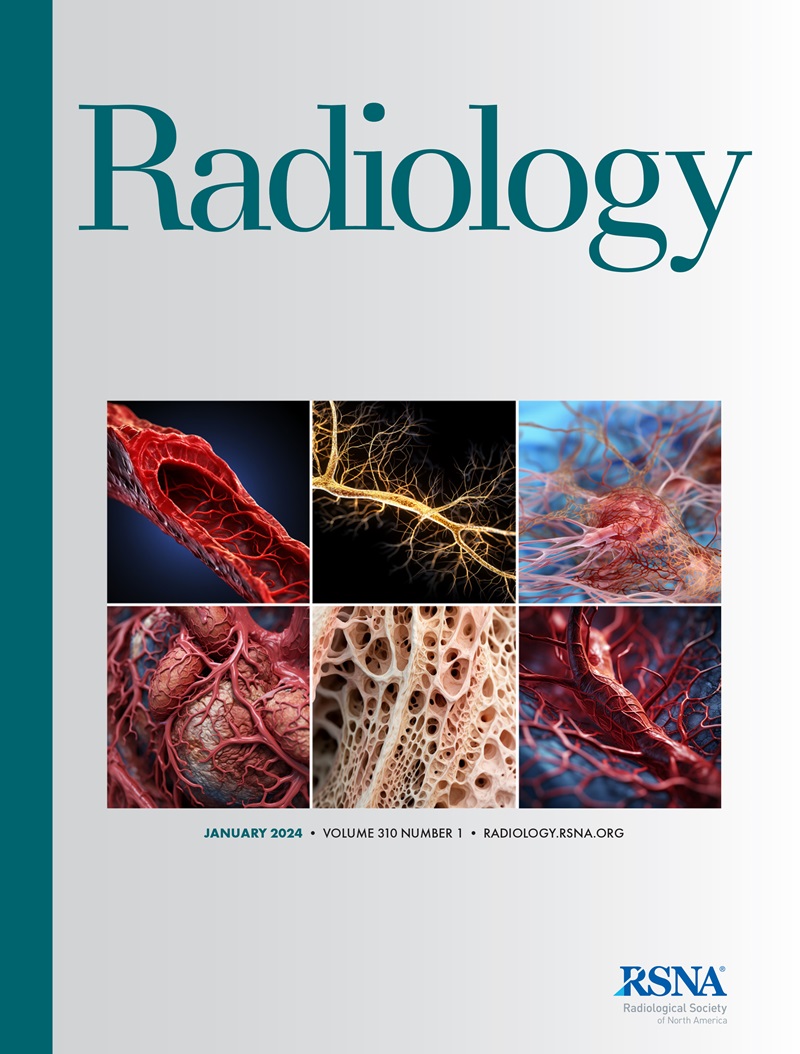人工智能决策支持对放射科医生乳腺x线筛查工作表现和视觉搜索的影响。
IF 15.2
1区 医学
Q1 RADIOLOGY, NUCLEAR MEDICINE & MEDICAL IMAGING
引用次数: 0
摘要
人工智能(AI)决策支持可以提高放射科医生在筛查乳房x光检查解释中的表现,但其对放射科医生视觉搜索行为的影响尚不清楚。目的比较在有和没有人工智能决策支持系统的情况下,放射科医生在阅读乳房x线筛查时的表现和视觉搜索模式。在这项回顾性多病例研究中,来自10家机构的12名具有4-32年经验(中位数为12年)的乳腺筛查放射科医生评估了2016年9月至2019年5月期间获得的筛查乳房x光片。评估是在没有辅助的情况下进行的,并使用了食品和药物管理局(Food and Drug administration)批准、欧盟委员会(European commission)标记的人工智能决策支持系统,该系统将地区的怀疑程度从1分到100分,其中100分表示最高的恶性可能性。眼球追踪器监测读者的眼球运动。使用多阅读器多病例分析软件比较非辅助和人工智能辅助阅读的受试者工作特征曲线下面积(AUC)、灵敏度和特异性。使用自举重采样(n = 20,000)比较阅读次数、乳房固定覆盖率(固定在2.5°视角半径内的乳房覆盖百分比)、固定时间和病变区域内首次固定时间。结果150例女性(中位年龄55岁[IQR, 50-63岁])进行乳房x线摄影检查(有乳腺癌75例,无乳腺癌75例);年龄范围49-72岁)。人工智能支持下的平均AUC高于独立阅读(独立阅读,0.93 [95% CI: 0.91, 0.96];ai支持,0.97 [95% CI: 0.95, 0.98];P < 0.001)。没有证据表明平均敏感性存在差异(81.7%[900个读数中的735个]vs 87.2%[900个读数中的785个];P = 0.06),特异性(89.0% [801 / 900]vs 91.1% [820 / 900];P = 0.46),或阅读时间(29.4 vs 30.8秒;P = .33)。人工智能支持的乳房固定覆盖率较低(11.1%对9.5%的乳房面积;P = 0.004),而病变区域的注视时间更高(4.4 vs 5.4秒;P = .006)。在病变区域内首次固定的时间上没有差异(3.4 vs 3.8秒;P = .13)。结论在人工智能支持下,放射科医生在阅读乳房x光片时提高了乳腺癌检测的准确性,在可疑区域花费更多的时间,而在乳房其他部位花费更少的时间,表明搜索效率更高。©RSNA, 2025本文可获得补充材料。参见沃尔夫在本期的社论。本文章由计算机程序翻译,如有差异,请以英文原文为准。
Influence of AI Decision Support on Radiologists' Performance and Visual Search in Screening Mammography.
Background Artificial intelligence (AI) decision support may improve radiologist performance during screening mammography interpretation, but its effect on radiologists' visual search behavior remains unclear. Purpose To compare radiologist performance and visual search patterns when reading screening mammograms with and without an AI decision support system. Materials and Methods In this retrospective multireader multicase study, 12 breast screening radiologists with 4-32 years of experience (median, 12 years) from 10 institutions evaluated screening mammograms acquired between September 2016 and May 2019. Assessments were conducted unaided and with a Food and Drug Administration-approved, European Commission-marked AI decision support system, which assigns a region suspicion score from 1 to 100, with 100 indicating the highest malignancy likelihood. An eye tracker monitored readers' eye movements. Area under the receiver operating characteristic curve (AUC), sensitivity, and specificity between unaided and AI-assisted reading were compared using multireader multicase analysis software. Reading times, breast fixation coverage (percentage breast covered by fixations within 2.5° visual angle radius), fixation time, and time to first fixation within the lesion region were compared using bootstrap resampling (n = 20 000). Results Mammography examinations (75 with breast cancer, 75 without breast cancer) from 150 women (median age, 55 years [IQR, 50-63 years]; age range, 49-72 years) were read. The mean AUC was higher with AI support versus unaided reading (unaided, 0.93 [95% CI: 0.91, 0.96]; AI-supported, 0.97 [95% CI: 0.95, 0.98]; P < .001). There was no evidence of a difference in mean sensitivity (81.7% [735 of 900 readings] vs 87.2% [785 of 900]; P = .06), specificity (89.0% [801 of 900] vs 91.1% [820 of 900]; P = .46), or reading time (29.4 vs 30.8 seconds; P = .33). Breast fixation coverage was lower with AI support (11.1% vs 9.5% of breast area; P = .004), while fixation time in the lesion region was higher (4.4 vs 5.4 seconds; P = .006). There was no evidence of a difference in time to first fixation within the lesion region (3.4 vs 3.8 seconds; P = .13). Conclusion Radiologists improved their breast cancer detection accuracy when reading mammography with AI support, spending more fixation time on suspicious areas and less on the rest of the breast, indicating a more efficient search. © RSNA, 2025 Supplemental material is available for this article. See also the editorial by Wolfe in this issue.
求助全文
通过发布文献求助,成功后即可免费获取论文全文。
去求助
来源期刊

Radiology
医学-核医学
CiteScore
35.20
自引率
3.00%
发文量
596
审稿时长
3.6 months
期刊介绍:
Published regularly since 1923 by the Radiological Society of North America (RSNA), Radiology has long been recognized as the authoritative reference for the most current, clinically relevant and highest quality research in the field of radiology. Each month the journal publishes approximately 240 pages of peer-reviewed original research, authoritative reviews, well-balanced commentary on significant articles, and expert opinion on new techniques and technologies.
Radiology publishes cutting edge and impactful imaging research articles in radiology and medical imaging in order to help improve human health.
 求助内容:
求助内容: 应助结果提醒方式:
应助结果提醒方式:


